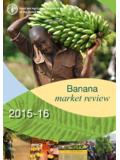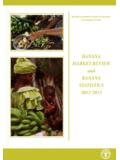Transcription of REGULATION (EC) No 850/2004 OF THE EUROPEAN …
1 Journal of the EUROPEAN UnionL 158/_____7 REGULATION (EC) No 850/2004 OF THE EUROPEAN PARLIAMENTAND OF THE COUNCILof 29 April 2004on persistent organic pollutantsand amending Directive 79/117/EECTHE EUROPEAN PARLIAMENT AND THE COUNCIL OF THE EUROPEAN UNION,Having regard to the Treaty establishing the EUROPEAN Community, and in particular Article 175(1)thereof,Having regard to the proposal from the Commission 1,Having regard to the Opinion of the EUROPEAN Economic and Social Committee 2,After consulting the Committee of the Regions,Acting in accordance with the procedure laid down in Article 251 of the Treaty 3, 1OJ C2OJ C3 Opinion of the EUROPEAN Parliament of 26 February 2004 (not yet published in the OfficialJournal) and Decision of the Council of 26 April Journal of the EUROPEAN UnionL 158/_____8 Whereas:(1)This REGULATION primarily concerns environmental protection and the protection of humanhealth.
2 The legal basis is therefore Article 175(1) of the Treaty.(2)The Community is seriously concerned by the continuous release of persistent organicpollutants into the environment. These chemical substances are transported acrossinternational boundaries far from their sources and they persist in the environment,bioaccumulate through the food web, and pose a risk to human health and the measures need therefore to be taken in order to protect human health and theenvironment against these pollutants.(3)In view of its responsibilities for the protection of the environment, the Community signed on24 June 1998 the Protocol to the 1979 Convention on Long-Range TransboundaryAir Pollution on Persistent organic Pollutants, hereinafter "the Protocol", and on22 May 2001 the Stockholm Convention on Persistent organic Pollutants, hereinafter "theConvention".
3 Journal of the EUROPEAN UnionL 158/_____9(4)While legislation at Community level relating to persistent organic pollutants has been put inplace, its main deficiencies are that there is an absence of, or incomplete legislation on,prohibition of the production and use of any of the currently listed chemicals, that there is noframework to subject additional persistent organic pollutant substances to prohibitions,restrictions or elimination, nor any framework to prevent the production and use of newsubstances that exhibit persistent organic pollutant characteristics. No emission reductiontargets, as such, have been set at Community level and the current release inventories do notcover all sources of persistent organic pollutants.(5)In order to ensure coherent and effective implementation of the Community's obligationsunder the Protocol and the Convention, it is necessary to establish a common legalframework, within which to take measures designed in particular to eliminate the production,placing on the market and use of intentionally produced persistent organic , persistent organic pollutants' characteristics should be taken into considerationin the framework of the relevant Community assessment and authorisation schemes.
4 (6)Coordination and coherence should be ensured when implementing at Community level theprovisions of the Rotterdam 1, Stockholm and Basel Conventions 2 and when participating inthe development of the Strategic Approach to International Chemicals Management (SAICM)within the United Nations framework. 1 Convention on the prior informed consent procedure for certain hazardous chemicals andpesticides in international Convention on the control of transboundary movements of hazardous wastes and Journal of the EUROPEAN UnionL 158/_____10(7)Moreover, considering that the provisions of this REGULATION are underpinned by theprecautionary principle as set forth in the Treaty, and mindful of Principle 15 of the RioDeclaration on Environment and Development and in view of the aim of elimination, wherefeasible, of the release of persistent organic pollutants into the environment, it is appropriatein certain cases to provide for control measures stricter than those under the Protocol and theConvention.
5 (8)In the future, the proposed REACH REGULATION could be an appropriate instrument by whichto implement the necessary control measures on production, placing on the market and use ofthe listed substances and the control measures on existing and new chemicals and pesticidesexhibiting persistent organic pollutants' characteristics. However, without prejudice to thefuture REACH REGULATION and since it is important to implement these control measures onthe listed substances of the Protocol and the Convention as soon as possible, this Regulationshould for now implement those Journal of the EUROPEAN UnionL 158/_____11(9)In the Community, the placing on the market and use of most of the persistent organicpollutants listed in the Protocol or the Convention has already been phased out as a result ofthe prohibitions laid down in Council Directive 79/117/EEC of 21 December 1978 prohibitingthe placing on the market and use of plant protection products containing certain activesubstances 1 and Council Directive 76/769/EEC of 27 July 1976 on the approximation of thelaws, regulations and administrative provisions of the Member States relating to restrictionson the marketing and use of certain dangerous substances and preparations 2.
6 However, inorder to fulfil the Community s obligations under the Protocol and the Convention and tominimise the release of persistent organic pollutants, it is necessary and appropriate also toprohibit the production of those substances and to restrict exemptions to a minimum so thatexemptions only apply where a substance fulfils an essential function in a specific application.(10) Exports of substances covered by the Convention and exports of lindane are regulated byRegulation (EC) No 304/2003 of the EUROPEAN Parliament and of the Council of28 January 2003 concerning the export and import of dangerous chemicals 3. 1OJ L 33, , p. 36. Directive as last amended by REGULATION (EC) No 807/2003 (OJ L122, , p. 36).2OJ L 262, , p.
7 201. Directive as last amended by CommissionDirective 2004/21/EC (OJ L 57, , p. 4).3OJ L 63, , p. 1. REGULATION as amended by Commission REGULATION (EC)No 1213/2003 (OJ L 169, , p. 27). Journal of the EUROPEAN UnionL 158/_____12(11) The production and use of hexachlorocyclohexane (HCH), including lindane, is subject torestrictions under the Protocol but not totally prohibited. That substance is still used in someMember States and therefore it is not possible to prohibit immediately all existing , in view of the harmful properties of HCH and the possible risks related to itsrelease into the environment, its production and uses should be confined to a minimum andultimately phased out by the end of 2007 at the latest.(12) Obsolete or carelessly managed stockpiles of persistent organic pollutants may seriouslyendanger the environment and human health through, for instance, contamination of soil andground water.
8 It is appropriate, therefore, to adopt provisions that go beyond the provisionslaid down in the Convention. Stockpiles of prohibited substances should be treated as waste,while stockpiles of substances the production or use of which is still allowed should benotified to the authorities and properly supervised. In particular, existing stockpiles whichconsist of or contain banned persistent organic pollutants should be managed as waste assoon as possible. If other substances are banned in the future, their stocks should also bedestroyed without delay and no new stockpiles should be built up. In view of the particularproblems of certain new Member States, adequate financial and technical assistance should beprovided through existing Community financial instruments, such as the Cohesion andStructural Journal of the EUROPEAN UnionL 158/_____13(13) In line with the Communication from the Commission on the Community Strategy forDioxins, Furans and Polychlorinated Biphenyls (PCBs) 1, and with the Protocol and theConvention, releases of persistent organic pollutants which are unintentional by-products ofindustrial processes should be identified and reduced as soon as possible with the ultimate aimof elimination, where feasible.
9 Appropriate national action plans, covering all sources andmeasures, including those provided for under existing Community legislation, should bedrawn up and implemented to reduce the releases continuously and cost-effectively as soon aspossible. To this end, appropriate tools should be developed in the framework of theConvention.(14) In line with that Communication, appropriate programmes and mechanisms should beestablished to provide adequate monitoring data on the presence of dioxins, furans and PCBsin the environment. However, it is necessary to ensure that appropriate tools are available andcan be used under economically and technically viable conditions. 1OJ C 322, , p. Journal of the EUROPEAN UnionL 158/_____14(15) Under the Convention, the persistent organic pollutant content in waste is to be destroyed orirreversibly transformed into substances that do not exhibit similar characteristics, unlessother operations are environmentally preferable.
10 Since current Community legislation onwaste does not lay down specific rules as regards those substances, they should be laid downin this REGULATION . To ensure a high level of protection, common concentration limits for thesubstances in waste should be established before 31 December 2005.(16) The importance of identifying and separating waste consisting of, containing or contaminatedby persistent organic pollutants at source in order to minimise the spreading of thesechemicals into other waste is recognised. Council Directive 91/689/EEC of12 December 1991 on hazardous waste 1 established Community rules on the management ofhazardous waste obliging Member States to take the necessary measures to require thatestablishments and undertakings which dispose of, recover, collect or transport hazardouswaste do not mix different categories of hazardous waste or mix hazardous waste withnon-hazardous waste.
















